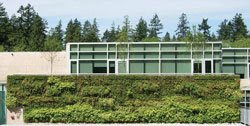Caroline Nolan from Green Roofs for Healthy Cities (GRHC) was kind enough to send me the recent winners of the 2008 Green Roof and Wall Design Awards. A few of the winning projects have been featured here on L+U as models of the ongoing Veg.itecture series. A few others are new information for me. Read on for some photos and click on the titles for more information about the winners. (all links and images via GRHC)
• The Residences at 900 North Michigan Ave. in Chicago, IL. – Hoerr Schaudt Landscape Architects, LLC (Intensive Green Roof – Residential Category)

:: image credit – Scott Shigley
:: image credit – Scott Shigley
• West Podium Park, Boston World Trade Center in Boston, MA. – Roofscapes, Inc. (Intensive Green Roof Industrial/Commercial Category)

:: image credit – Pressley Associates, Inc
• Austin City Hall in Austin, TX – McKinney Kelley JV Landscape Architects (Intensive Green Roof – Institutional Category)


:: image credit – American Hydrotech
• Vancouver Aquarium in Vancouver, B.C.– Sharp & Diamond Landscape Architecture Inc. (Green Wall Design Category)

• 909 Walnut Fidelity Tower Building in Kansas City, MO – Jeffrey L. Bruce & Company (Extensive Green Roof – Residential Category)
• TWA Corporate Headquarters Building in Kansas City, MO – el dorado inc. (Extensive Green Roof – Industrial Commercial Category)
• California Academy of Sciences in San Francisco, CA – Rana Creek Living Architecture (Extensive Green Roof-Institutional Category)
A few notes on the winners, and how the market and implementation of green roofs have evolved through the years. It is definitely true to form that the winners encompass a range of project types, including green walls, along with a fusion of extensive and intensive projects. I haven’t really followed the awards for a few years – as it’s typically a similar cross section of projects upon review… a few regional projects, along with some stellar examples of world-class design precedents. I think I will take the time to sift through the criteria and all of the winners over the years to see if I can discern if these show the breadth of winners that rise above the rest – and more particularly to see if there are any trends that emerge. Perhaps just an academic exercise, but having submitted before, it’s always interesting to see how the winners stack up against the projects that you’ve done and not won for (or maybe it’s just how they are submitted…?)
Final thoughts… It’s interesting that there is no awards given for single-family residential project – which is a smaller (total) but burgeoning (potentially) part of the overall green roof projects. I assume you can submit a project in the residential category, and then compete with much higher end rooftop gardens. Perhaps this is due to the market being driven by designers and manufacturers that are more focused on larger scale commericial, industrial, and institutional projects along with a variety of smaller mixed use buildings. It would be great to add this residential category to give a different project scale. It’s also interesting to see how industrial and commerical are lumped into the same category – as these typically have vastly disparate goals of aesthetics (think low-maintenance extensive versus high-maintenance rooftop terrace)
Alas, it’s always educational to see awards – as it’s someone’s task to sift through numerous entries, probably all deserving of praise, and tease out which ones are specifically cutting edge. Nonetheless, over the past 6 years, it’s been great to see the award winning projects and I do applaud GRHC for continuing to get green roofs (and now, recently green walls) on the radar and continue to promote their effectiveness and marketability – as well as the varying shades of green these rooftops encompass.






Jason,
Your post raises a few interesting questions. Truely, residential greenscape architecture does not get as much exposure in the media for two reasons. 1. The budgets rarely equal those of commercial projects and so are limited in their design potential and 2. those that can afford to equal the expenditure do not wish to advertise the locations of their homes or of their environmental budgets.
Green roofs are expensive. Our firm has been involved in over 100 residential projects and less than ten have given permission for use on our website. Hopefully the trend will successfully continue and our clients will be willing to share their inspired designs.
As a past winner of a GRHC award, we would enjoy sharing small of our smaller work with potential clients.
http://www.intrinsiclandscaping.com
Thanks for the comment Tom and perspective from the trenches. I understand the budget issue – which is part of my thought why it should be a separate issue. Most residential green roofs here in Portland people are all about showing them off – but in the cases where it’s not desired, I guess they don’t get awards 🙂
Perhaps something for GRHC (and us all) to think about as well – as the concept has grown to include living walls, maybe more coverage of single-family residential is needed as well.
Jason,
Living walls are extremely cool. We are challenged in the mid west to make them as dramatic as they are in your climates on the west coast. If any viewers have plant suggestions that maintain interesting structure and colors through out the dormant season, I would be very interested in learning about them.
Mayor Daley is pushing for ever more creative implementations in downtown commercial buildings. Perhaps we should take our creative lead from the residential market.
Regards,
Tom Cooper
COO
Intrinsic Landcaping
Interesting thread or discussion.
I will take forth your suggestions to implement a single-family residential category to the higher powers here at Green Roofs for Healthy Cities!